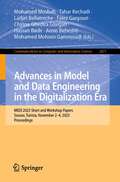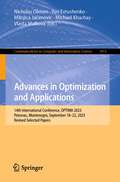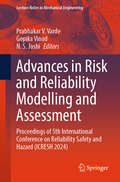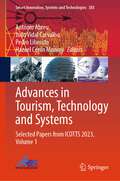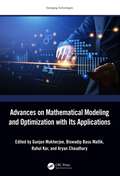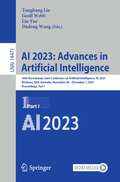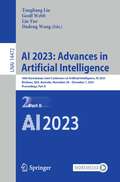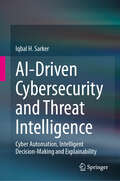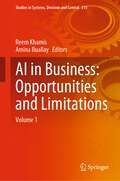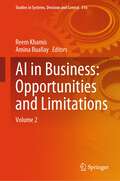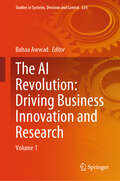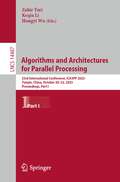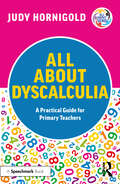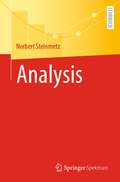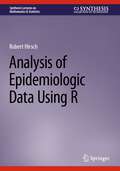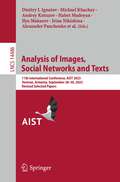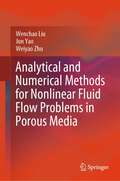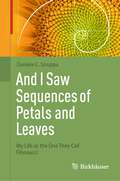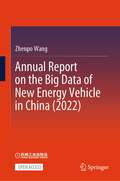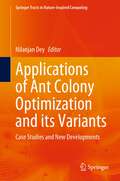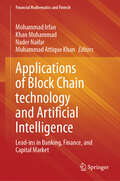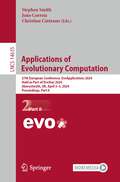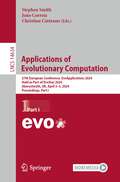- Table View
- List View
Advances in Model and Data Engineering in the Digitalization Era: Medi 2021 International Workshops: Detect, Sias, Csmml, Bioc, Heda, Tallinn, Estonia, June 21-23, 2021, Proceedings (Communications In Computer And Information Science Ser. #1481)
by Mohamed Mosbah Tahar Kechadi Ladjel Bellatreche Faiez Gargouri Chirine Ghedira Guegan Hassan Badir Amin Beheshti Mohamed Mohsen GammoudiAdvances in Optimization and Applications: 14th International Conference, OPTIMA 2023, Petrovac, Montenegro, September 18–22, 2023, Revised Selected Papers (Communications in Computer and Information Science #1913)
by Nicholas Olenev Yuri Evtushenko Milojica Jaćimović Michael Khachay Vlasta MalkovaThis book constitutes the refereed proceedings of the 14th International Conference on Advances in Optimization and Applications, OPTIMA 2023, held in Petrovac, Montenegro, during September 18–22, 2023.The 21 full papers included in this book were carefully reviewed and selected from 68 submissions. They were organized in topical sections as follows: mathematical programming; global optimization; continuous optimization; discrete and combinatorial optimization; optimal control; game theory and mathematical economics; optimization in economics and finance; and applications.
Advances in Risk and Reliability Modelling and Assessment: Proceedings of 5th International Conference on Reliability Safety and Hazard (ICRESH 2024) (Lecture Notes in Mechanical Engineering)
by Prabhakar V. Varde Gopika Vinod N. S. JoshiThis book presents the proceedings of the 5th International Conference on Reliability Safety & Hazard-2024, held in Mumbai during February 21–24, 2024. It covers the latest advances in artificial intelligence and machine learning in development of risk-conscious culture. Various topics covered in this volume are reliability prediction, precursor event analysis, fuzzy reliability, structural reliability, passive system reliability, digital system reliability, risk-informed approach to decision making, dynamic PSA, uncertainty and sensitivity modeling, among others. The book is a valuable resource for researchers and professionals working in both academia and industry in the areas of complex systems, safety-critical systems, and risk-based engineering.
Advances in Tourism, Technology and Systems: Selected Papers from ICOTTS 2023, Volume 1 (Smart Innovation, Systems and Technologies #383)
by António Abreu João Vidal Carvalho Pedro Liberato Hazael Cerón MonroyThis book features a collection of high-quality research papers presented at the International Conference on Tourism, Technology and Systems (ICOTTS 2023), held at Anáhuac University, Bacalar, Mexico, from 2 to 4 November 2023. The book is divided into two volumes, and it covers the areas of technology in tourism and the tourist experience, generations and technology in tourism, digital marketing applied to tourism and travel, mobile technologies applied to sustainable tourism, information technologies in tourism, digital transformation of tourism business, e-tourism and tourism 2.0, big data and management for travel and tourism, geotagging and tourist mobility, smart destinations, robotics in tourism, and information systems and technologies.
Advances on Mathematical Modeling and Optimization with Its Applications (Emerging Technologies)
Advances on Mathematical Modeling and Optimization with Its Applications discusses optimization, equality, and inequality constraints and their application in the versatile optimizing domain. It further covers non-linear optimization methods such as global optimization, and gradient-based non-linear optimization, and their applications. Discusses important topics including multi-component differential equations, geometric partial differential equations, and computational neural systems Covers linear integer programming and network design problems, along with an application of the mixed integer problems Discusses constrained and unconstrained optimization, equality, and inequality constraints, and their application in the versatile optimizing domain Elucidates the application of statistical models, probability models, and transfer learning concepts Showcases the importance of multi-attribute decision modeling in the domain of image processing and soft computing The text is primarily for senior undergraduate and graduate students, and academic researchers in the fields of mathematics, statistics, and computer science.
Advances on Mathematical Modeling and Optimization with Its Applications (Emerging Technologies)
by Gunjan Mukherjee Biswadip Basu Mallik Rahul Kar Aryan ChaudharyAdvances on Mathematical Modeling and Optimization with Its Applications discusses optimization, equality, and inequality constraints and their application in the versatile optimizing domain. It further covers non-linear optimization methods such as global optimization, and gradient-based non-linear optimization, and their applications. Discusses important topics including multi-component differential equations, geometric partial differential equations, and computational neural systems Covers linear integer programming and network design problems, along with an application of the mixed integer problems Discusses constrained and unconstrained optimization, equality, and inequality constraints, and their application in the versatile optimizing domain Elucidates the application of statistical models, probability models, and transfer learning concepts Showcases the importance of multi-attribute decision modeling in the domain of image processing and soft computing The text is primarily for senior undergraduate and graduate students, and academic researchers in the fields of mathematics, statistics, and computer science.
AI 2023: 36th Australasian Joint Conference on Artificial Intelligence, AI 2023, Brisbane, QLD, Australia, November 28–December 1, 2023, Proceedings, Part I (Lecture Notes in Computer Science #14471)
by Tongliang Liu Geoff Webb Lin Yue Dadong WangThis two-volume set LNAI 14471-14472 constitutes the refereed proceedings of the 36th Australasian Joint Conference on Artificial Intelligence, AI 2023, held in Brisbane, QLD, Australia during November 28 – December 1, 2023. The 23 full papers presented together with 59 short papers were carefully reviewed and selected from 213 submissions. They are organized in the following topics: computer vision; deep learning; machine learning and data mining; optimization; medical AI; knowledge representation and NLP; explainable AI; reinforcement learning; and genetic algorithm.
AI 2023: 36th Australasian Joint Conference on Artificial Intelligence, AI 2023, Brisbane, QLD, Australia, November 28–December 1, 2023, Proceedings, Part II (Lecture Notes in Computer Science #14472)
by Tongliang Liu Geoff Webb Lin Yue Dadong WangThis two-volume set LNAI 14471-14472 constitutes the refereed proceedings of the 36th Australasian Joint Conference on Artificial Intelligence, AI 2023, held in Brisbane, QLD, Australia during November 28 – December 1, 2023. The 23 full papers presented together with 59 short papers were carefully reviewed and selected from 213 submissions. They are organized in the following topics: computer vision; deep learning; machine learning and data mining; optimization; medical AI; knowledge representation and NLP; explainable AI; reinforcement learning; and genetic algorithm..
AI-Driven Cybersecurity and Threat Intelligence: Cyber Automation, Intelligent Decision-Making and Explainability
by Iqbal H. SarkerThis book explores the dynamics of how AI (Artificial Intelligence) technology intersects with cybersecurity challenges and threat intelligence as they evolve. Integrating AI into cybersecurity not only offers enhanced defense mechanisms, but this book introduces a paradigm shift illustrating how one conceptualize, detect and mitigate cyber threats. An in-depth exploration of AI-driven solutions is presented, including machine learning algorithms, data science modeling, generative AI modeling, threat intelligence frameworks and Explainable AI (XAI) models. As a roadmap or comprehensive guide to leveraging AI/XAI to defend digital ecosystems against evolving cyber threats, this book provides insights, modeling, real-world applications and research issues. Throughout this journey, the authors discover innovation, challenges, and opportunities. It provides a holistic perspective on the transformative role of AI in securing the digital world.Overall, the useof AI can transform the way one detects, responds and defends against threats, by enabling proactive threat detection, rapid response and adaptive defense mechanisms. AI-driven cybersecurity systems excel at analyzing vast datasets rapidly, identifying patterns that indicate malicious activities, detecting threats in real time as well as conducting predictive analytics for proactive solution. Moreover, AI enhances the ability to detect anomalies, predict potential threats, and respond swiftly, preventing risks from escalated. As cyber threats become increasingly diverse and relentless, incorporating AI/XAI into cybersecurity is not just a choice, but a necessity for improving resilience and staying ahead of ever-changing threats. This book targets advanced-level students in computer science as a secondary textbook. Researchers and industry professionals working in various areas, such as Cyber AI, Explainable and Responsible AI, Human-AI Collaboration, Automation and Intelligent Systems, Adaptive and Robust Security Systems, Cybersecurity Data Science and Data-Driven Decision Making will also find this book useful as reference book.
AI in Business: Volume 1 (Studies in Systems, Decision and Control #515)
by Reem Khamis Amina BuallayThis book is a comprehensive guide to understanding the potential of artificial intelligence (AI) in improving business functions, as well as the limitations and challenges that come with its implementation. In this book, readers will learn about the various opportunities that AI presents in business, including how it can automate routine tasks, reduce errors, and increase efficiency. The book covers a range of topics, including how AI can be used in financial reporting, auditing, fraud detection, and tax preparation. However, the book also explores the limitations of AI in business, such as the need for skilled professionals, data quality, and the potential for bias. It examines the challenges that companies face when implementing AI in business functions, including the need for ethical considerations, transparency, and accountability. The book is written for business professionals, business leaders, and anyone interested in the potential of AI in business functions. It offers practical advice on how to implement AI effectively and provides insights into the latest developments in AI technology. Through case studies and real-world examples, readers will gain a deeper understanding of how AI can be used to enhance business functions, as well as the potential pitfalls and limitations to be aware of. Overall, "AI in Business: Opportunities and Limitations" is an essential guide for anyone looking to harness the power of AI to improve their business functions, and to stay ahead in an increasingly competitive business environment.
AI in Business: Volume 2 (Studies in Systems, Decision and Control #516)
by Reem Khamis Amina BuallayThis book is a comprehensive guide to understanding the potential of artificial intelligence (AI) in improving business functions, as well as the limitations and challenges that come with its implementation. In this book, readers will learn about the various opportunities that AI presents in business, including how it can automate routine tasks, reduce errors, and increase efficiency. The book covers a range of topics, including how AI can be used in financial reporting, auditing, fraud detection, and tax preparation. However, the book also explores the limitations of AI in business, such as the need for skilled professionals, data quality, and the potential for bias. It examines the challenges that companies face when implementing AI in business functions, including the need for ethical considerations, transparency, and accountability. The book is written for business professionals, business leaders, and anyone interested in the potential of AI in business functions. It offers practical advice on how to implement AI effectively and provides insights into the latest developments in AI technology. Through case studies and real-world examples, readers will gain a deeper understanding of how AI can be used to enhance business functions, as well as the potential pitfalls and limitations to be aware of. Overall, this book is an essential guide for anyone looking to harness the power of AI to improve their business functions and to stay ahead in an increasingly competitive business environment.
The AI Revolution: Volume 1 (Studies in Systems, Decision and Control #524)
by Bahaa AwwadThis comprehensive book explores the transformative role of artificial intelligence (AI) in business innovation and research. It provides a solid foundation in AI technologies, such as machine learning, natural language processing, and computer vision, and examines how they reshape business models and revolutionize industries. The book highlights the strategic implications of AI in enhancing customer experience, optimizing operations, and enabling data-driven decision-making. It explores the integration of AI with emerging trends like IoT, blockchain, and cloud computing for innovation. The role of AI in advancing scientific discovery and academic research is also explored, addressing challenges and opportunities in AI-driven methodologies. Organizational and ethical dimensions of AI implementation are considered, including talent acquisition, skills development, and data governance. Real-world case studies showcase AI's transformative power across diverse industries. This forward-thinking guide equips academics, researchers, and business leaders with knowledge and insights to harness the potential of AI and contribute to innovation and research.
Algorithms and Architectures for Parallel Processing: 23rd International Conference, ICA3PP 2023, Tianjin, China, October 20–22, 2023, Proceedings, Part I (Lecture Notes in Computer Science #14487)
by Zahir Tari Keqiu Li Hongyi WuThe 7-volume set LNCS 14487-14493 constitutes the proceedings of the 23rd International Conference on Algorithms and Architectures for Parallel Processing, ICA3PP 2023, which took place in Tianjin, China, during October 2023.The 145 full papers included in these proceedings were carefully reviewed and selected from 439 submissions. ICA3PP covers many dimensions of parallel algorithms and architectures; encompassing fundamental theoretical approaches; practical experimental projects; and commercial components and systems.
All About Dyscalculia: A Practical Guide for Primary Teachers (All About SEND)
by Judy HornigoldAll About Dyscalculia is an accessible and informative guide for primary school teachers, designed to increase their knowledge and understanding of dyscalculia and provide practical strategies and advice to build the self-esteem and motivation of learners in their care. The book explores the indicators of dyscalculia, before detailing a range of teaching strategies that will support dyscalculic children and help them to develop their mathematical understanding and resilience. Throughout the book, there is an emphasis on creating an empathetic learning ethos in the classroom and school that will minimise maths anxiety and lead to a more positive outcome for all learners. All About Dyscalculia includes: A comprehensive introduction to dyscalculia and steps to help teachers identify children with dyscalculia in their classrooms. Practical strategies for building specific maths abilities, as well as broader problem-solving skills. Advice for teachers and parents on how to reduce maths anxiety and support the development of maths proficiency in learners. Easy to dip in and out of chapters with worked examples make this book accessible to all teachers and parents. With suggestions for immediate impact, as well as ideas for more detailed interventions, this practical book will be essential reading for all mainstream primary teachers and SENCOs, as well as a helpful guide to supporting children with dyscalculia at home.
All About Dyscalculia: A Practical Guide for Primary Teachers (All About SEND)
by Judy HornigoldAll About Dyscalculia is an accessible and informative guide for primary school teachers, designed to increase their knowledge and understanding of dyscalculia and provide practical strategies and advice to build the self-esteem and motivation of learners in their care. The book explores the indicators of dyscalculia, before detailing a range of teaching strategies that will support dyscalculic children and help them to develop their mathematical understanding and resilience. Throughout the book, there is an emphasis on creating an empathetic learning ethos in the classroom and school that will minimise maths anxiety and lead to a more positive outcome for all learners. All About Dyscalculia includes: A comprehensive introduction to dyscalculia and steps to help teachers identify children with dyscalculia in their classrooms. Practical strategies for building specific maths abilities, as well as broader problem-solving skills. Advice for teachers and parents on how to reduce maths anxiety and support the development of maths proficiency in learners. Easy to dip in and out of chapters with worked examples make this book accessible to all teachers and parents. With suggestions for immediate impact, as well as ideas for more detailed interventions, this practical book will be essential reading for all mainstream primary teachers and SENCOs, as well as a helpful guide to supporting children with dyscalculia at home.
Analysis
by Norbert SteinmetzDas Buch wendet sich sowohl an Studierende aller mathematischen Fachrichtungen und mathematisch interessierte Studierende der Physik als auch an Dozentinnen und Dozenten, die den Aufbau ihres ersten Analysiskurses noch vor sich haben oder Anregungen für ihre Vorlesungen suchen. Inhalt und Form sind entstanden und vielfach erprobt in immer wieder kritisch veränderten und angepassten 3-semestrigen Analysiskursen. Etwa 2/3 des Buches decken die Erfordernisse einer 2-semestrigen Grundvorlesung Analysis ab, wohingegen das restliche Drittel Elemente der Fourieranalysis, der Differentialgeometrie, der gewöhnlichen Differentialgleichungen und der Funktionentheorie behandeln, Themen, denen eigenständige Vorlesungen auch weiterhin zu wünschen sind. Zu den Besonderheiten zählen die parallele und miteinander verzahnte Einführung des Riemann- und Lebesgueintegrals, die Einbettung einfacher Elemente der komplexen in die reelle Analysis, ausgedehnte Anwendungen – von der Heisenbergschen Unschärferelation über die Lösung der Wärmeleitungsgleichung bis hin zur Black-Scholes-Formel – sowie die Darstellung der Methode von Ostrogradski und des Dixon-Beweises der allgemeinen Cauchyschen Integralformel. Dass an verschiedenen Stellen die eingefahrenen Pfade verlassen wurden, wird der kundigen Leserschaft nicht verborgen bleiben. Die Frage „abstrakt oder anschaulich-verständlich“ wird konsequent zugunsten des letzteren entschieden. Die Übungsaufgaben sind in den laufenden Text eingebaut in der Hoffnung, dass sie so mehr Beachtung finden. Schließlich vermitteln die historischen Anmerkungen und Kurzbiographien einen Eindruck davon, wie die Analysis sich entwickelt hat und wer wesentlich an dieser Entwicklung beteiligt war.
Analysis of Epidemiologic Data Using R (Synthesis Lectures on Mathematics & Statistics)
by Robert HirschThis book addresses the description and analysis of occurrence data frequently encountered in epidemiological studies. With the occurrence of Covid-19, people have been exposed to the analysis and interpretation of epidemiological data. To be informed consumers of this information, people need to understand the nature and analysis of these data. Effort is made to emphasize concepts rather than mathematics. Subjects range from description of the frequencies of disease to the analysis of associations between the occurrence of disease and exposure. Those analyses begin with simple associations and work up to complex relationships that involve the control of extraneous characteristics. Analyses rely on the statistical software R, which is freeware in wide use by professional epidemiologists and other scientists.
Analysis of Images, Social Networks and Texts: 11th International Conference, AIST 2023, Yerevan, Armenia, September 28–30, 2023, Revised Selected Papers (Lecture Notes in Computer Science #14486)
by Dmitry I. Ignatov Michael Khachay Andrey Kutuzov Habet Madoyan Ilya Makarov Irina Nikishina Alexander Panchenko Maxim Panov Panos M. Pardalos Andrey V. Savchenko Evgenii Tsymbalov Elena Tutubalina Sergey ZagoruykoThis book constitutes revised selected papers from the thoroughly refereed proceedings of the 11th International Conference on Analysis of Images, Social Networks and Texts, AIST 2023, held in Yerevan, Armenia, during September 28-30, 2023. The 24 full papers included in this book were carefully reviewed and selected from 93 submissions. They were organized in topical sections as follows: natural language processing; computer vision; data analysis and machine learning; network analysis; and theoretical machine learning and optimization. The book also contains one invited talk in full paper length.
Analytical and Numerical Methods for Nonlinear Fluid Flow Problems in Porous Media
by Wenchao Liu Jun Yao Weiyao ZhuThis book investigates in detail the mathematical methods and computation methods in efficient solution of some open nonlinear seepage flow problems involved in engineering problems. Developed engineering technologies and some relevant practical field applications are also provided. The introduced open nonlinear problems include nonlinear quadratic pressure gradient term problem, compressible gas seepage flow problem and low-velocity non-Darcy seepage flow problem. Studies on these nonlinear seepage flow problems have attracted engineers and scientists from various disciplines, such as geo-energy engineering, civil and environmental engineering, fluid mechanics, applied mathematics and computation. In particular, the book systematically establishes a fundamental theory for a strongly nonlinear problem of low-velocity non-Darcy seepage flow from a new perspective of moving boundary, while emphasizing the usage of mathematical linearization transformation methods and computational methods into the analytical and numerical solution of the strongly nonlinear partial differential equations. Sufficient knowledge of mathematics is always introduced ahead of model solution to assist readers. And the procedure of strict formula deduction in the model solution process is provided in detail. High-solution figures and tables from model solution are rich in the book. Therefore, it is very helpful for the readers to master the nonlinear model solution methods and engineering technologies. The book is intended for upper undergraduate students and graduate students who are interested in engineering technology, fluid mechanics and applied mathematics, researchers and engineers working on geo-energy science and engineering and field applications.
And I Saw Sequences of Petals and Leaves: My Life as the One They Call Fibonacci
by Daniele C. StruppaIn this captivating historical novel, Daniele Struppa skillfully weaves a fictional autobiography, bringing Fibonacci to life with vivid details of his upbringing and adult years in Medieval Europe. As we explore the historical context of Fibonacci's time, we delve into the intriguing aspects of a bygone era, painting a compelling picture of a man whose contributions to mathematics continue to resonate today. From his groundbreaking work on congruent numbers to the famous numerical sequence that bears his name, the author invites readers to imagine the creative sparks that ignited Fibonacci's mathematical innovations. When historical evidence is elusive, accuracy and passion are seamlessly combined, offering plausible scenarios grounded in documented facts. A meticulously crafted apparatus of notes distinguishes fact from fiction, providing readers with a clear guide to navigate this enthralling reconstruction of Fibonacci's life. Step into the medieval world of Leonardo Fibonacci, one of the most celebrated mathematicians in history, and discover the man behind the mathematical genius. Mathematicians and curious readers alike will appreciate the allure of Fibonacci's mathematical brilliance.
Annual Report on the Big Data of New Energy Vehicle in China (2022)
by Zhenpo WangThis is an Open Access book. This book based on static indicators and dynamic big data from local electric vehicles, is the first New-Energy Vehicles (NEVs) research report on the Big Data in China. Using the real-time big data collected by China's National Monitoring and Management Platform for NEVs, this book delves into the main annual technological progress of NEVs, the vehicle operating characteristics, it also anticipates the trend of NEVs industry.Various graphs & charts, detailed data this book offers will familiarize readers with the operation characteristics and practical application of China's NEVs industry and popularize the concept of automobile electrification. Besides, this book also makes an objective evaluation of the current situation and technological improvement of China's NEVs industry, presenting sensible suggestions for the development of the industry.This book is written for government staff, researchers, college staff, and technical staff of automobile and spare parts enterprises, which serves as an important reference for the decision-making of government departments and strategic decisions of automotive companies.
Applications of Ant Colony Optimization and its Variants: Case Studies and New Developments (Springer Tracts in Nature-Inspired Computing)
by Nilanjan DeyThis book explains the basic ideas behind several variants of ant colony optimization (ACO) and shows how they may be used in real-world settings like manufacturing, engineering design, and health care. Marco Dorigo proposed ACO for the first time, and it has been used to solve a variety of optimization problems. This book presents the latest developments of ACO.
Applications of Block Chain technology and Artificial Intelligence: Lead-ins in Banking, Finance, and Capital Market (Financial Mathematics and Fintech)
by Mohammad Irfan Khan Muhammad Muhammad Attique Khan Nader NaifarToday, emerging technologies offer a new pathway for advancing the economy in the fields of banking, finance, and capital markets. Blockchain applications play a crucial role in ensuring trust and security within these industries by relying on transparency and visibility through peer-to-peer networks. The banking industry has also witnessed increased operations speed, better transparency, efficiency enhancement, fraud extenuation at less cost while sharing real-time data between various parties. Thus, the adoption of blockchain in the Banking and Insurance industry is developing very fast. It has emerged as the commonly accepted default platform for the banking and insurance industry. This book explores how blockchain technology optimizes and integrates transactions and operations, facilitating easier access to information. This, in turn, has the potential to reduce communication costs and minimize minor data transfer errors. Additionally, the book delves into the current applications of blockchain technology in the financial industry, discusses its limitations, and outlines its future prospects for broader accessibility. This book is aimed at students and researchers in financial engineering and fintech and it can serve as a reference for identifying problem areas and their possible solutions.
Applications of Evolutionary Computation: 27th European Conference, EvoApplications 2024, Held as Part of EvoStar 2024, Aberystwyth, UK, April 3–5, 2024, Proceedings, Part II (Lecture Notes in Computer Science #14635)
by Stephen Smith João Correia Christian CintranoThe two-volume set LNCS 14634 and 14635 constitutes the refereed proceedings of the 27th European Conference on Applications of Evolutionary Computation, EvoApplications 2024, held as part of EvoStar 2024, in Aberystwyth, UK, April 3–5, 2024, and co-located with the EvoStar events, EvoCOP, EvoMUSART, and EuroGP.The 51 full papers presented in these proceedings were carefully reviewed and selected from 77 submissions. The papers have been organized in the following topical sections: applications of evolutionary computation; analysis of evolutionary computation methods: theory, empirics, and real-world applications; computational intelligence for sustainability; evolutionary computation in edge, fog, and cloud computing; evolutionary computation in image analysis, signal processing and pattern recognition; evolutionary machine learning; machine learning and AI in digital healthcare and personalized medicine; problem landscape analysis for efficient optimization; softcomputing applied to games; and surrogate-assisted evolutionary optimisation.
Applications of Evolutionary Computation: 27th European Conference, EvoApplications 2024, Held as Part of EvoStar 2024, Aberystwyth, UK, April 3–5, 2024, Proceedings, Part I (Lecture Notes in Computer Science #14634)
by Stephen Smith João Correia Christian CintranoThe two-volume set LNCS 14634 and 14635 constitutes the refereed proceedings of the 27th European Conference on Applications of Evolutionary Computation, EvoApplications 2024, held as part of EvoStar 2024, in Aberystwyth, UK, April 3–5, 2024, and co-located with the EvoStar events, EvoCOP, EvoMUSART, and EuroGP.The 51 full papers presented in these proceedings were carefully reviewed and selected from 77 submissions. The papers have been organized in the following topical sections: applications of evolutionary computation; analysis of evolutionary computation methods: theory, empirics, and real-world applications; computational intelligence for sustainability; evolutionary computation in edge, fog, and cloud computing; evolutionary computation in image analysis, signal processing and pattern recognition; evolutionary machine learning; machine learning and AI in digital healthcare and personalized medicine; problem landscape analysis for efficient optimization; softcomputing applied to games; and surrogate-assisted evolutionary optimisation.
